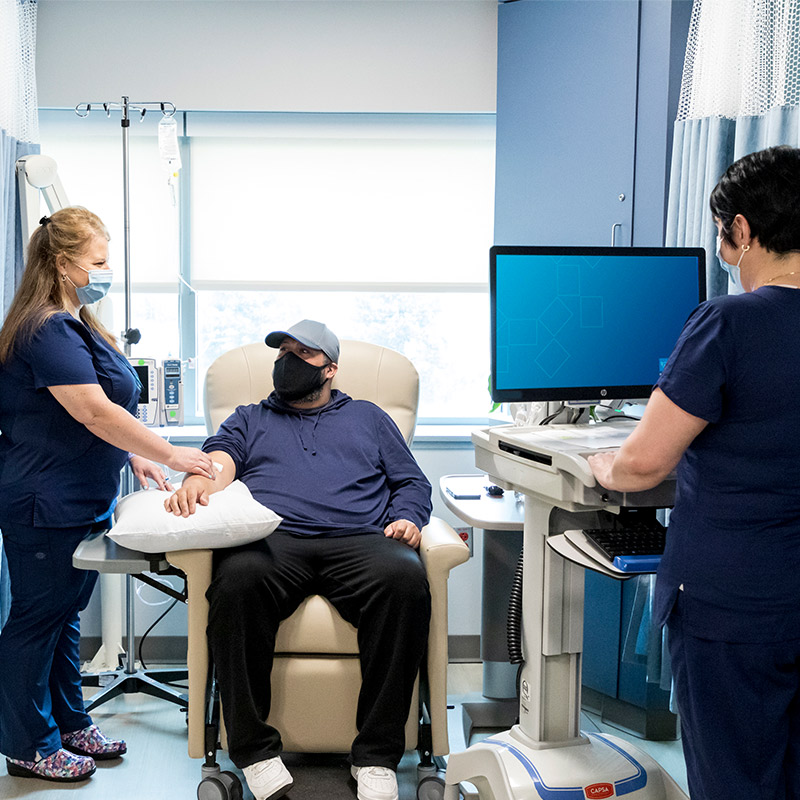Multiple Sclerosis: A Simple Overview of a Complex Disease

April 24, 2019
We’ve all been there. Symptoms arise, and so we hightail it to the office of Dr. Google. Searching for answers to silence our fears, however, we are only left with more questions.
Case in point: blurred vision, weakness and numbness are all common symptoms of multiple sclerosis, better known as MS. However, they are also common symptoms for a host of other diseases and conditions, including anemia, dehydration, migraines and Lyme’s Disease.
With about 1 million people in the U.S. affected by MS but only a 0.2% chance of developing the disease, how can you be sure your symptoms are actually pointing to a MS diagnosis? Are there telltale signs and/or risk factors, and how do we distinguish fact from fiction?
What is MS?
MS is a chronic disease of the central nervous system (consisting of the brain, spinal cord and optic nerves), which can affect an individual’s ability to write, speak or walk, as a result of a disruption of electrical conduction. MS is not contagious or directly inherited, but there are various risk factors including gender, genetics, age, environmental factors, and geography, that can play a role in development of the disease.
Krupa Pandey, M.D., a fellowship trained MS specialist at the Multiple Sclerosis Center, part of Hackensack University Medical Center’s Neuroscience Institute, explains, “MS occurs when myelin, the fatty tissue that surrounds the wires in the central nervous system, as well as the wires themselves are attacked and damaged by an overactive immune system. This damage results in scar tissue called sclerosis. Symptoms arise because the nerves can no longer effectively send electrical impulses to and from the brain.”
Who is at risk for MS?
While MS can affect anybody, it is much more common in women. Other risk factors include tobacco use, obesity, and possibly low vitamin D levels. MS is more common in families in which others have MS or other autoimmune conditions.
MS affects all ages, but is most often diagnosed between the ages of 20 and 35, and the most common subtype, MS with relapses, is two to three times more common in women than men. Overall, the average person has a 1 in 500 chance of developing MS.
“The current pattern suggests that the further one lives from the equator, the higher the prevalence of MS,” explains Dr. Pandey. “The belief is that less sun exposure results in lower vitamin D levels, and lower vitamin D levels may activate the immune system in a way so that people with a genetic risk may acquire MS.”
What are common symptoms of MS?
“MS is an unpredictable disease, and it affects people differently. While some may only have mild symptoms, others may have more serious impairments,” shares Florian Thomas, M.D., Ph.D., director of the Multiple Sclerosis Center and chair of the Neuroscience Institute and the Department of Neurology at Hackensack University Medical Center. “Symptoms and signs can be short-term, or long lasting.”
How is MS diagnosed?
“Other diseases may mimic MS, which is why it’s important to conduct a series of careful testing – a review of medical history, a neurological exam, an MRI of the brain and spinal cord, multiple blood tests, and at times a spinal fluid analysis are all used for diagnosis,” shares Dr. Thomas.
Can MS be cured? If not, how is MS treated?
“Currently, there is no cure for MS, yet. However, long-term remission is possible. Treatment is broken down into several parts: treatment for the relapse, prevention of further relapses with preventative agents and treatment of the symptoms that are left behind after a relapse is over,” Dr. Pandey adds.
Treatment options are all dependent on the patient and the symptoms they experience. Along with injectable treatments, oral treatments and infusions, patients may benefit from a variety of other therapies and treatment options like neuropsychology, swallow and speech therapy, physical and occupational therapy, sexual dysfunction care and resilience counseling.
What diseases are often mistaken for MS?
“Many conditions can mimic MS such as stroke, migraine, Lyme disease and rheumatological conditions such as Lupus,” says Dr. Thomas. “With similar signs and symptoms, it’s important to be able to rule out other conditions.”
What are common misconceptions about MS?
“The most common misconception about MS is that it only happens in young individuals – this is not true. While the most common ages of diagnosis are between 20 and 35, you can develop MS at any age,” Dr. Pandey mentions.
“Another misconception is that you’ll definitely end up with a wheel chair, walker, cane or assistive device – which is also false. While this may happen for some individuals, the likelihood for this to happen has greatly decreased over the past 30 years,” she adds.
“The last common fallacy is that there are only a limited number of options for treatment. There are actually a variety of treatment options, including close to 20 disease modifying drugs, and all depend on the patient’s unique needs. My advice for anyone who’s been diagnosed with MS is to find a center that provides comprehensive treatment with a variety of health care professionals in addition to neurologists, such as psychologists, urologists, ophthalmologists and specialists in physical, occupational, speech & cognitive rehabilitation, who can address your various physical and emotional needs.”
As a neurologist, also board certified in spinal cord medicine and neural repair and rehabilitation, Dr. Thomas is passionate about helping patients with MS focus on healthy living and live well despite the disease.
“For patients with MS it’s important to remember the long-term perspective. Before missing scheduled treatments, opting not to exercise or choosing a sub-optimal diet, I want them to think of their long-term goals, and use that as a guiding light,” shares Dr. Thomas. “Everything they do in the present will influence what life will be like half a century from now; I hope for all of my patients that they’ll be able to enjoy dancing at a grandchild’s wedding.”
Dr. Florian Thomas is a neurologist and fellowship trained neuroimmunologist; he serves as director of the Multiple Sclerosis Center and chair of the Neuroscience Institute and the Department of Neurology at Hackensack University Medical Center. Dr. Krupa Pandey is a fellowship trained multiple sclerosis neurologist at the center as well. To schedule an appointment with Dr. Thomas or Dr. Pandey, call 551-996-8100.
To learn more about MS or to make an appointment with one of our specialists, visit HackensackUMC.org/Multiple-Sclerosis. To find another provider near you, visit HackensackMeridianHealth.org.
Sources:
National Multiple Sclerosis Society
The material provided through HealthU is intended to be used as general information only and should not replace the advice of your physician. Always consult your physician for individual care.
Find a doctor near me
Maintaining Your Fitness Goals with Wearables

Maintain your fitness goals using wearables. Learn about smartwatches, fitness trackers, and more. Improve your health journey today.
Find a doctor near me

The Facts on ALS
ALS facts from leading doctors. Learn about prevention, risk factors, and current treatments. Find support and resources. Call 800-822-8905.

Restaurant Owner Faces MS Diagnosis
Restaurant owner Darrell Wordelmann's MS journey: Find expert care & support at Jersey Shore University Medical Center's MS Center. Learn more.

Can Physical Therapy Help Your Arthritis?
Manage arthritis pain? Physical therapy may help improve mobility and range of motion. Learn more and schedule an appointment today.

Are Stroke Symptoms Different for Young People?
Learn about stroke symptoms in young adults from Dr. Miller. Understand risk factors & prevention strategies for a healthier life. Schedule an appointment today.

